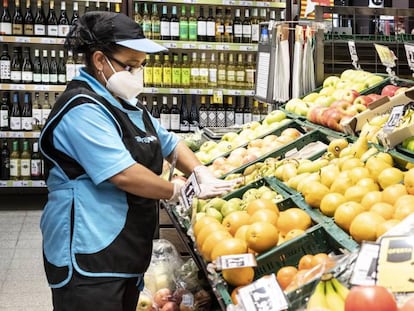Where is inflation going? ‘Kaizen’ has the answer
The process of continuous improvement, as seen in Amazon’s strategy, plays an important role in price fluctuations

Consumer price indices have increased considerably almost everywhere in the world, reaching year-on-year rates of change in many cases not seen since the 1970s. The debate about whether these increases are transitory or permanent has become politicized, based, in many cases, on preconceived opinions. Those who have always maintained that growing central bank balance sheets and large fiscal debt and deficits would cause inflation say they saw it coming – even if that prediction hasn’t been true for a couple of decades and still isn’t in Japan. Those perennially concerned about second-round effects – wage increases that could follow price increases – have raised their hypothetical level of alarm, even though there is scant evidence to date. For now, we are seeing one-off price increases in many sectors, with multiple and diverse causes, rather than an increase in inflation due to macroeconomic factors. Of course, it is possible that inflation is persistently rising. But there are also factors that suggest the opposite. Do you know what kaizen is? Read to the end to find out what it is and why it matters.
The distinction between price increases and inflation seems like a semantic argument, but it is not. Because, let’s think for a moment, what is inflation? Strictly speaking, inflation is the rate of change in prices. But what exactly do we mean when we are concerned about inflation? A sustained and widespread increase in prices? An increase in inflation expectations? A simultaneous increase in wages and prices?
In the current episode, prices are rising in many sectors due to a combination of two factors: the persistent (but not permanent) effect of the post-Covid reopening on the composition of demand for goods and services; and rising commodity prices due to a combination of production shortages and changes in demand.
The post-Covid reopening has generated a drastic increase in the consumption of goods compared to the consumption of services, which has generated the already famous bottlenecks in international trade. And this drastic increase in the demand for goods, combined with a hyper-optimized and fragile global supply chain, which has been broken at multiple points, has generated a severe scarcity effect and an exponential increase in the prices of some of these goods. The best example is the price of cars in the United States. Due to, among other things, a shortage of semiconductors, used car prices have increased by almost 40% in 2021 – and, as a result, almost half of the increase in core inflation in the US in 2021 has been due to the price of used cars. Is this a one-off increase in prices or inflation? It will take time to digest these bottlenecks, but at some point, normalcy will return in the auto sector once the semiconductor shortage is over and those price increases will be dampened or could be partially reversed. If underlying inflation rapidly weakens as a result, will it be a one-off drop in prices or deflation?
Similarly, the exponential increase in the prices of some commodities, such as natural gas, responds to the combination of an increase in the demand for goods, which are very energy-intensive to manufacture, and a scarce and rigid supply due, among other factors, to the uncertainty derived from the ecological transition policies. Once the demand for goods normalizes, energy prices may fall. If this drags down overall inflation, will it be a one-off drop in prices or deflation?
For now, we are seeing one-off price increases in many sectors, with multiple and diverse causes, rather than an increase in inflation due to macroeconomic factors
Of course, the intensity of consumption derived from the success of the economic policies adopted to manage the Covid-19 crisis has contributed to these price increases. But any analysis of price increases based on the typical Philips curve – which explains price variations as a function of excess demand, inflation expectations and exogenous supply factors – will conclude that most of the increase in prices is due to exogenous supply factors.
That is why it is perhaps more useful to analyze what is happening in the economy that can anticipate where inflation will stabilize in the coming years, once these exogenous supply factors dissipate. How has the economy changed during the pandemic?
One of the most important changes is the drastic increase in online consumption, initially forced by restrictions on mobility but with signs of becoming something habitual in our lives. The convenience of making three clicks on your cellphone and receiving the order at home is just too tempting. What does this imply for future inflation?
The key may lie in the Japanese word kaizen: the process of continuous improvement. As Christopher Mims recounts in a fascinating book, Arriving Today, Amazon’s decision to promise “delivery in two days” with Amazon Prime accelerated the process of optimizing commercial distribution, and increasing the automation and productivity of the sector. And this almost certainly implies a formidable counterpoint to inflationary pressures.
Because the Amazon method turns commercial distribution centers into manufacturing plants. If you buy a book, a t-shirt and an iron on Amazon, these three products will arrive at those distribution centers from all over the world, and from there, they will be assembled into a package with your name on it. The sophisticated process of assembly of individual orders – the “fulfillment” of these orders – uses the optimization techniques of industrial manufacturing, of kaizen: the constant elimination of inefficiencies and the reduction of process volatility and uncertainty, where algorithms set the tone and pace and humans complete processes that robots do not yet know how to do.
Humans perform repetitive and physically intense tasks at the pace set by algorithms and the assembly line, and are remunerated with attractive salaries that compensate for the hardness of the work and the productivity generated. That is why Amazon and similar companies, wherever they are, set the bottom of low-skilled wages and generate competitive pressure to increase productivity. That is why wage increases in the US, which for now are concentrated in the lower part of the wage distribution, have not translated into generalized increases in the wage structure.
Inflation is notoriously difficult to predict, and more so in periods of multiple shocks like the current one. The failures and successes of future economic policy, which will define the anchoring of inflation expectations, and the adoption of kaizen in ever larger parts of the economy, are much more important in determining its future evolution than the extent of current price increases.
Tu suscripción se está usando en otro dispositivo
¿Quieres añadir otro usuario a tu suscripción?
Si continúas leyendo en este dispositivo, no se podrá leer en el otro.
FlechaTu suscripción se está usando en otro dispositivo y solo puedes acceder a EL PAÍS desde un dispositivo a la vez.
Si quieres compartir tu cuenta, cambia tu suscripción a la modalidad Premium, así podrás añadir otro usuario. Cada uno accederá con su propia cuenta de email, lo que os permitirá personalizar vuestra experiencia en EL PAÍS.
¿Tienes una suscripción de empresa? Accede aquí para contratar más cuentas.
En el caso de no saber quién está usando tu cuenta, te recomendamos cambiar tu contraseña aquí.
Si decides continuar compartiendo tu cuenta, este mensaje se mostrará en tu dispositivo y en el de la otra persona que está usando tu cuenta de forma indefinida, afectando a tu experiencia de lectura. Puedes consultar aquí los términos y condiciones de la suscripción digital.











































